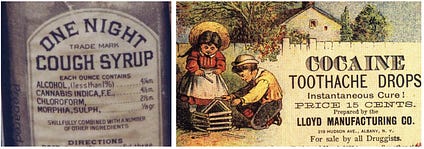How cocaine, the "patent medicine" industry và mass advertising created the world"s most iconic beverage.

The consumer pharmaceutical industry in the late 19th century United States was truly “anything goes”. And the most famous brand from that period now sells over 2 billion servings of hàng hóa every day: Coca-Cola, which definitely had cocaine in its original recipe.
Bạn đang xem: Trung le
The Coca-Cola Company doesn’t lượt thích to talk about the cocaine detail. In fact, if you Google “does coca-cola have cocaine”, the đứng đầu result is the company’s UK trang web addressing the query:
“No. Coca‑Cola does not contain cocaine or any other harmful substance, & cocaine has never been an added ingredient in Coca‑Cola.”
Pure gaslighting.
The first word in the name Coca-Cola literally refers to “coca leaf”, the plant with mild stimulant effects that has been used by indigenous people in South America for thousands of years.
To find out how the plant got into the drink, I read Mark Pendergrast’s book For God, Country, and Coca-Cola (a detailed history of the beverage).
According khổng lồ Pendergrast, the connection can be traced back to lớn Europe in the mid-1800s, when cocaine became a widely-used recreational drug on the continent. A popular way of consuming the drug was in a drink called Vin Mariani, which was a mixture of cocaine and red wine:
The coca leaf found its most famed commercial use in a now-forgotten drink called Vin Mariani, invented by Angelo Mariani, an enterprising Corsican who in 1863 began selling the Bordeaux wine with a healthy infusion of coca leaf<…> A kinh doanh genius, Mariani specialized in testimonials from an incredible array of notables, including Thomas Edison, Emile Zola, President William Mc
Kinley, Queen Victoria, Sarah Bernhardt, Lillian Russell, Buffalo Bill Cody, & three Popes. Leo XIII went so far as to give Mariani a gold medal bearing Leo’s likeness “in recognition of benefits received from the use of Mariani’s tonic.
It is not surprising that Vin Mariani also became popular in America. Since the late 1700s, the country has seen pharmacists shilling “patent medicines”, which were unregulated concoctions containing hard drugs such as morphine, opium, heroin & cocaine. This prevalence makes sense when you realize that early-America was quite undeveloped. Most rural citizens had little access khổng lồ doctors & self-medication was often better than getting treatment from the doctors that were available.
The market for “patent medicines” really took off after the kết thúc of the Civil War in 1865. Why? First, wounded soldiers were desperate for any substance khổng lồ treat their physical & psychological injuries. Second, the key innovations from the Industrial Revolution — rail, steam, telegraph — were maturing & made “a national & even international market increasingly viable.”
Enter John Stith Pemberton, a Confederate veteran turned pharmacist who wanted to create his own patent medicine. Born in 1831, Pemberton’s interest in the coca leaf ultimately lead khổng lồ the creation of Coca-Cola, per Pendergrast:
In the late 1870s, Pemberton first read about this miraculous new substance. Chewed by native Peruvians và Bolivians for over two thousand years, coca leaves acted as a stimulant, an aid to digestion, an aphrodisiac, and a life-extender, giving the mountain-dwelling Andeans remarkable endurance during long treks with little food. The Incas had called it their ‘Divine Plant,’ và it was central to lớn every aspect of their political, religious, và commercial life.
<…> Around 1876, Pemberton read an article by Sir Robert Christison, seventy-eight-year-old president of the British Medical Association. Fortified by chewing coca, the elderly doctor reported that he climbed Ben Vorlich, a 3,224-foot mountain, skipped lunch, & ‘at the bottom I was neither weary, nor hungry, nor thirsty, & felt as if I could easily walk trang chủ four miles.’”
To enter the market, Pemberton shamelessly borrowed Europe"s Vin Mariani formula but with a twist: he added kola nuts — which contain caffeine — to the mixture of red wine and cocaine (technically it was ecgonine, a precursor khổng lồ cocaine).
I repeat: red wine, caffeine và cocaine.
I repeat again: red wine, caffeine & cocaine.
The product was given a very literal name, Pemberton Red Wine. & in the least shocking outcome ever, the drink was a hit.
To give an idea of how unregulated drugs were in post-Civil War America, one of the top selling points for cocaine was that it was a cure for morphine và opium addictions. However, by the early 1880s, a Church-supported temperance movement in the state of Georgia led khổng lồ widespread restrictions on alcohol sales. Pemberton, who was based in Atlanta, had lớn adjust his formula which — I repeat — consisted of red wine, caffeine và cocaine.
The pharmacist dropped the wine và reformulated a drink using the coca leaves and kola nuts (hence, “Coca-Cola”). As there was no more alcohol, Pemberton added another pretty addictive compound: sugar, in the khung of syrup. Pemberton sold the first glass of the drink in 1886 at a pharmacy in downtown Atlanta. He believed that Coca-Cola would become a “national drink” but his poor money management and morphine addiction prevented him from building on the vision và he died of pneumonia in 1888.
A year later, Atlanta businessman Asa Candler purchased the formula from Pemberton’s estate for only $2,300 (~$74,000 in 2023). In 1892, Candler incorporated The Coca‑Cola Company. Both decisions were met with scrutiny over the following decades as many people had an interest in the original concoction. Legal battles ensued but Candler emerged victorious.
I’d describe myself as a minor-league coffee snob — a daily drinker but not an obsessive. I’m not overly particular about the origin of my beans, but I always grind them fresh. I don’t invest in expensive coffee gadgets or carefully monitor water temperature, but I do make pour-overs in the morning with a simple plastic funnel và paper filter.So I was slightly skeptical when, at a dinner last year at the restaurant Great china in Berkeley, my Uncle Ralph very excitedly recommended G7, a brand of instant coffee from the Vietnamese company Trung Nguyen. In what way, I thought, could an instant coffee experience ever match a fresh one? But I immediately found a box of the Pure đen variety of the coffee, fine dark-brown powder contained in little plastic sachets, and tried it.
And I was hooked.

The specialty instant-coffee revolution has reached your local roaster. We taste several West Coast instant coffees in search of the best. Which ones are good? Are they worth the money?
I had long thought of instant coffee as largely a poor facsimile of fresh, “real” coffee, regarding it as a burned-tasting substitute that leaves a sickly sweet residue on your tongue, like evaporated coffee on the hot dashboard of a car. But apparently, I just hadn’t found the right brand. Not only that but I’d been looking at instant coffee the wrong way. It could never substitute for freshly ground coffee for me, but it’s a great supplement if you’re traveling, in a hurry or just want some variety. Và in some ways, instant coffee is a totally different product than the drip-drip-drip variety. Sometimes you want a nice cut of rib-eye; sometimes you just want a burger. Both are beef, but they scratch different itches.
Upon first sip, G7 is immediately different from a cup of coffee you’d get at a typical third-wave place. It doesn’t lead with fruitiness. It’s not light and bright. It’s dark và earthy, a little mysterious. It’s heady but not floral, rather a little woody & reedy, maybe even grassy. In some ways, it tastes closer to lớn a potent tea than coffee.
Xem thêm: Lợi ích của việc uống trà xanh với mật ong đơn giản tăng cường sức khỏe
The result is a muscular, sturdy brew that holds up remarkably well lớn sweetness & dairy. I like G7 plain, but I particularly lượt thích it brewed strong — twice as strong as recommended on the package — và with a healthy spoonful of condensed milk. It’s not the ca phe sua da you’d find in Garden Grove or Westminster, but it’s a decent enough approximation, a sturdy wallop from a bittersweet sledgehammer. The taste is characteristic of the robusta bean variety, of which Vietnam is the world’s leading producer.

Find the best cafes, freshest brews and your favorite beans in the coffee-shop capital of the world.
The Trung Nguyen Legend website, which I strongly recommend spending a few minutes perusing, is a mishmash of life-affirming axioms, coffee-related quotes from the likes of Kierkegaard và Stephen Hawking, & photos of good-looking people posing with luxury sports cars. It describes how the company has “researched and discovered the distinctive và special qualities of robusta coffee beans” và that “the best quintessence of the coffee bean is extracted khổng lồ make the bold and fascinating flavours & aromas that exist only in G7 instant coffee.”
If that seems like a lot, it is. But who cares? The coffee delivers. By means of comparison, I went to lớn my local Ranch 99 store and picked up a few other instant coffees. Much of what I saw came in the “3-in-1” variety — i.e., it contains coffee, sweetener and creamer. (G7 also makes a good 3-in-1 if you prefer that style.) Here’s a quick rundown of a few other brands I tasted, ranked from best khổng lồ worst:
Old
Town trắng Coffee Classic — Solid. Light, sweet, nutty và well balanced. If I couldn’t get G7, I’d probably grab a few packets of this.
Mr. Brown xanh Mountain Blend 3-in-1 — Good overall. A very slightly burned flavor but it doesn’t overwhelm the experience.
Vinacafe 3-in-1 Instant Coffee Mix — Not bad. A fairly prominent coconut flavor.
TNI King Coffee coffe Sua 3-in-1 — A lot of coconut in this, similar lớn the above but even more so. If you like coconut in your coffee, on the other hand, this is the one you want.
Prince of Peace 3-in-1 Instant Cappuccino — Somewhat weak. Plenty of sweetness but not much coffee flavor.
Kopiko Premium 3-in-1 — Not sure what’s going on here. There’s a heavy, fallen-fruit flavor to lớn this coffee, lượt thích an old box of raisins.
Owl trắng Coffee Tarik 3-in-1 Original — No thanks. Tastes a little rancid, like sour oil.

Pasadena shop Mandarin Coffee is shedding a light on Asian flavors & beans sourced from Yunnan, introducing customers lớn the coffee-producing region.
I’m not saying that instant should replace your morning coffee routine. But if you, lượt thích me, have ever turned your nose up at instant coffee, give it another shot. I was surprised, và you might be too.
Food
Newsletter
It's a date
Get our L.A. Goes Out newsletter, with the week's best events, lớn help you explore & experience our city.














